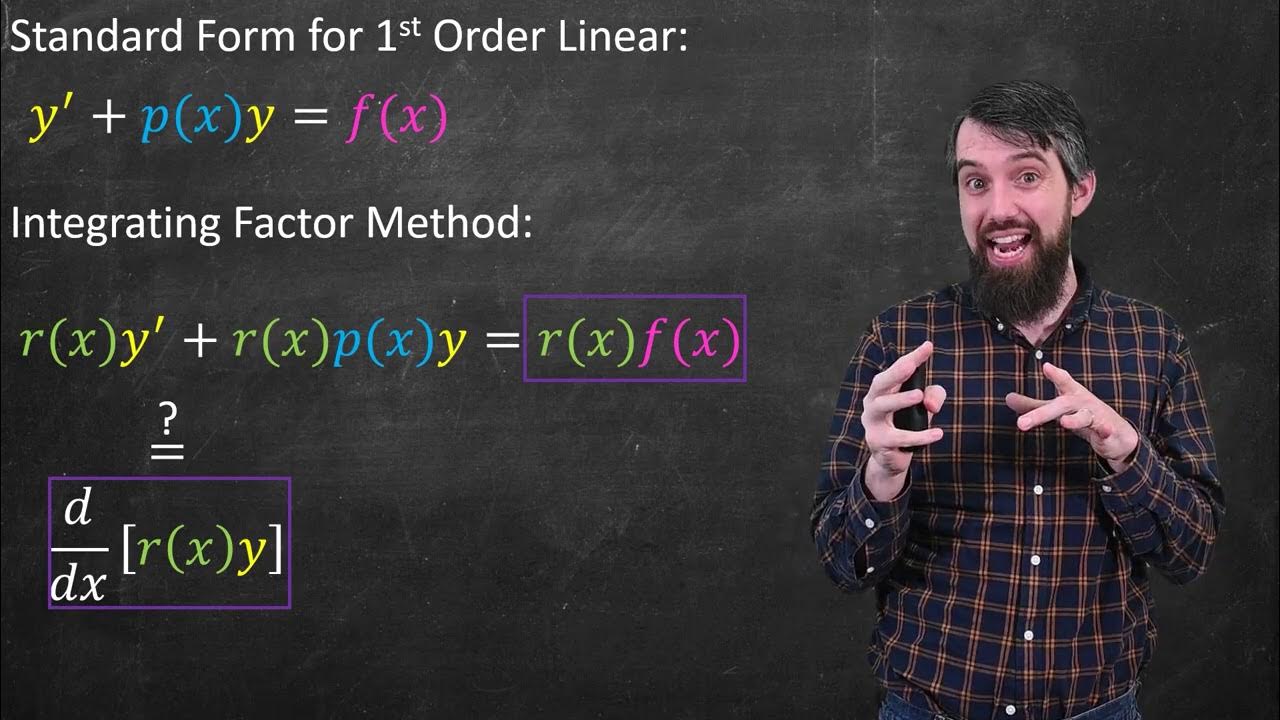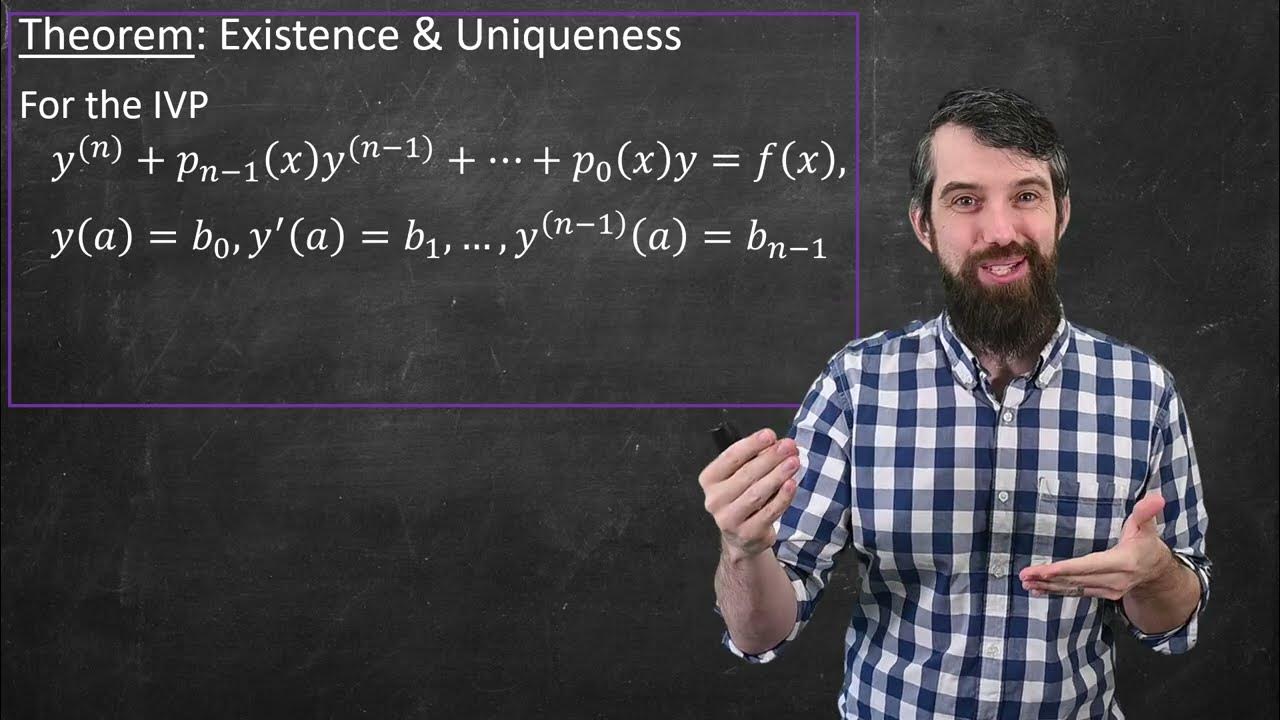How to Solve Constant Coefficient Homogeneous Differential Equations
TLDRThis educational video introduces the method to solve constant coefficient differential equations, a key topic in the broader playlist on differential equations. The presenter explains the concept, using a second-order example to illustrate the process. The solution involves guessing an exponential form, deriving the characteristic equation, and solving for constants 'r'. The general solution is a linear combination of exponential functions, with coefficients determined by initial conditions. The video concludes with solving for specific constants using a system of linear equations, providing a foundation for further exploration of different cases in subsequent videos.
Takeaways
- 📚 The video is a tutorial on solving constant coefficient differential equations, part of a larger playlist on differential equations.
- 🔍 A constant coefficient differential equation is defined by coefficients of the dependent variable and its derivatives being constant numbers, not functions of x.
- 🧠 The methodology involves making an educated guess for the solution form, specifically guessing a solution of the form \( e^{rt} \) where \( r \) is an unknown number.
- 🔑 The process includes substituting the guessed solution into the differential equation, which simplifies to a characteristic equation that must be solved for \( r \).
- 📈 The characteristic equation for the example given is \( r^2 - r - 6 = 0 \), which factors into \( (r - 3)(r + 2) = 0 \), yielding solutions \( r = 3 \) and \( r = -2 \).
- 🔍 The general solution to the differential equation is a linear combination of the exponential functions corresponding to the roots of the characteristic equation, \( c_1e^{3t} + c_2e^{-2t} \).
- 🔑 The solution requires two linearly independent solutions, which are provided by the exponential functions with the different roots.
- 🔄 To find specific values for the constants \( c_1 \) and \( c_2 \), two initial conditions are needed, one for \( y \) and one for its derivative \( y' \).
- 📉 The initial conditions are applied to the general solution and its derivative to form a system of linear equations, which can be solved for the constants.
- 🔢 The example given uses initial conditions \( y(0) = 1 \) and \( y'(0) = 2 \), leading to a system of equations that solve for \( c_1 = \frac{4}{5} \) and \( c_2 = \frac{1}{5} \).
- 🔚 The final solution to the initial value problem is given by \( \frac{4}{5}e^{3t} + \frac{1}{5}e^{-2t} \), illustrating the application of the methodology.
- 🔄 The video concludes by mentioning that there are multiple cases to consider when solving second order constant coefficient differential equations, which will be explored in subsequent videos.
Q & A
What is a constant coefficient differential equation?
-A constant coefficient differential equation is a linear differential equation where the coefficients of the dependent variable and its derivatives are all constant numbers, not functions of x.
What is the order of the differential equation in the script example?
-The order of the differential equation in the script example is two, as the highest derivative present is the second derivative.
What is the general form of the solution that the speaker guessed for the differential equation?
-The speaker guessed that the solution to the differential equation is of the form e^(rt), where r is an unknown number.
What is the characteristic equation derived from the guessed solution?
-The characteristic equation derived from the guessed solution is r^2 - r - 6 = 0, which is a quadratic equation in the variable r.
What are the two solutions to the characteristic equation in the script example?
-The two solutions to the characteristic equation are r = 3 and r = -2.
What are the two linearly independent solutions that form the general solution of the differential equation?
-The two linearly independent solutions that form the general solution are e^(3t) and e^(-2t).
What are the initial conditions given in the script?
-The initial conditions given are y(0) = 1 and y'(0) = 2.
How does the speaker find the constants c1 and c2 in the general solution?
-The speaker uses the initial conditions to set up a system of linear equations and solves for the constants c1 and c2.
What are the values of c1 and c2 after applying the initial conditions?
-The values of c1 and c2 after applying the initial conditions are c1 = 4/5 and c2 = 1/5.
What is the final answer to the initial value problem presented in the script?
-The final answer to the initial value problem is 4/5 * e^(3t) + 1/5 * e^(-2t).
What will be discussed in the next video according to the script?
-In the next video, the speaker will dive into the general methodology and theory for solving all different types of second order constant coefficient differential equations.
Outlines
📚 Introduction to Solving Constant Coefficient Differential Equations
The video introduces the topic of solving constant coefficient differential equations, which are characterized by coefficients that are constants rather than functions of x. The presenter explains that these are second-order equations, as the highest derivative involved is the second derivative. The methodology involves making an educated guess of the solution in the form of e^(rt), where r is an unknown constant. By substituting this guess into the equation, a characteristic equation is derived, which is a quadratic in r. Solving this quadratic gives the roots that determine the form of the general solution. The presenter also discusses the importance of linearly independent solutions and how they are combined to form the general solution of the differential equation.
🔍 Applying Initial Conditions to Find Specific Solutions
This paragraph delves into the application of initial conditions to determine the specific constants in the general solution of a second-order constant coefficient differential equation. The presenter sets up two initial conditions, one for the function y at t=0 and another for its derivative y' at the same point. By taking the derivative of the general solution and substituting the initial conditions, a system of linear equations is formed. The solution to this system yields the specific values of the constants c1 and c2. The presenter then illustrates the process of solving this system, resulting in the final specific solution to the initial value problem. The paragraph concludes with a teaser for the next video, which will explore different cases and the general theory for solving such differential equations.
Mindmap
Keywords
💡Constant Coefficient Differential Equation
💡Differential Equations
💡Characteristic Equation
💡Second Order
💡Linearly Independent
💡General Solution
💡Initial Conditions
💡Methodology
💡Quadratic Equation
💡Solution
Highlights
Introduction to solving constant coefficient differential equations.
Explanation of what constitutes a constant coefficient differential equation.
The methodology involves making a guess for the solution form.
Substitution of the guessed solution into the differential equation.
Derivation of the characteristic equation from the substitution.
Solving the characteristic equation to find possible values of r.
Identification of the general solution involving exponential functions.
Discussion on the linear independence of the solutions.
Combining solutions into a general solution with coefficients c1 and c2.
Introduction of initial conditions to find specific values of c1 and c2.
Differentiation of the general solution to apply initial conditions for y'.
Formation of a system of linear equations from initial conditions.
Solving the system of equations to determine c1 and c2.
Final solution to the initial value problem with specific constants.
Preview of upcoming videos covering different cases in solving such equations.
Encouragement for viewers to like the video and engage with the content.
Invitation for viewers to ask questions in the comments section.
Transcripts
Browse More Related Video

Undetermined Coefficients: Solving non-homogeneous ODEs

Converting a Higher Order ODE Into a System of First Order ODEs

Linear Differential Equations & the Method of Integrating Factors

The Theory of 2nd Order ODEs // Existence & Uniqueness, Superposition, & Linear Independence

The Theory of Higher Order Differential Equations

Second Order Linear Differential Equations
5.0 / 5 (0 votes)
Thanks for rating: